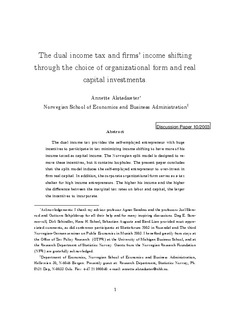| dc.contributor.author | Alstadsæter, Annette | |
| dc.date.accessioned | 2006-08-04T08:21:51Z | |
| dc.date.available | 2006-08-04T08:21:51Z | |
| dc.date.issued | 2003-07 | |
| dc.identifier.issn | 0804-6824 | |
| dc.identifier.uri | http://hdl.handle.net/11250/162852 | |
| dc.description.abstract | The dual income tax provides the self-employed entrepreneur with huge
incentives to participate in tax minimizing income shifting to have more of his
income taxed as capital income. The Norwegian split model is designed to remove
these incentives, but it contains loopholes. The present paper concludes
that the split model induces the self-employed entrepreneur to over-invest in
firm real capital. In addition, the corporate organizational form serves as a tax
shelter for high income entrepreneurs. The higher his income and the higher
the difference between the marginal tax rates on labor and capital, the larger the incentives to incorporate. | en |
| dc.format.extent | 364647 bytes | |
| dc.format.mimetype | application/pdf | |
| dc.language.iso | eng | en |
| dc.publisher | Norwegian School of Economics and Business Administration. Department of Economics | en |
| dc.relation.ispartofseries | Discussion paper | en |
| dc.relation.ispartofseries | 2003:10 | en |
| dc.title | The dual income tax and firms’ income shifting through the choice of organizational form and real capital investments | en |
| dc.type | Working paper | en |
